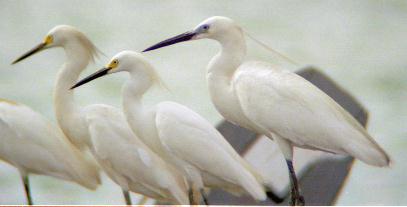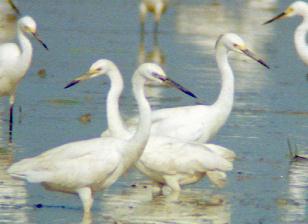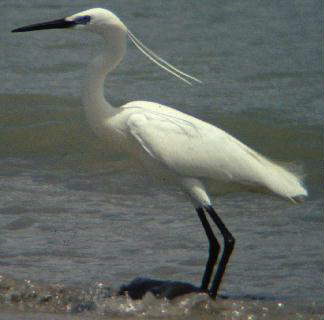PHOTO GALLERY
Juveniles (page 1)
Adults together (page 2)
Head profiles (page 3)




| SOUTHEASTERN CARIBBEAN BIRDS PHOTO GALLERY |
||||||||||||||||||||
| Trinidad and Tobago Field Naturalists' Club Southeastern Caribbean Bird Alert Trinidad and Tobago Rare Bird Committee |
||||||||||||||||||||
| IDENTIFICATION ESSAYS | ||||||||||||||||||||
| Little Egret (Egretta garzetta) and Snowy Egret (E. thula): Page 2 of 3 | ||||||||||||||||||||
| Photo Index Juveniles (page 1) Adults together (page 2) Head profiles (page 3) |
||||||||||||||||||||
 |
||||||||||||||||||||
| Fig. 1. Alternate plumaged adult Little Egret at right with two alternate plumaged Snowy Egrets at San Fernando, Trinidad, 25 April 2002. Photo © by Brett Hayes. This photo illustrates the following distinctions between the two species: (1) larger, thicker bill of Little Egret; (2) bluish lores typical of Little Egret (but highly variable, sometimes pale yellowish, whitish, greyish, greenish, reddish or even chestnut) compared with yellow lores of adult Snowy Egret (may be greyish in immatures, reddish when breeding); (3) relatively flatter forehead of Little Egret compared with steeper forehead of Snowy Egret; (4) long, lanceolate head plumes of alternate plumaged Little Egret compared with the shaggy filamentous head plumes of Snowy Egret; and (5) longer neck and larger body size of Little Egret. | ||||||||||||||||||||
 |
||||||||||||||||||||
| Fig. 2. Basic plumaged Little Egret (centre) foraging with Snowy Egrets at Caroni Rice Fields, Trinidad, 6 July 2002. Photo © by Floyd Hayes. Note the distinctly longer and heavier bill and the bluish lores of the Little Egret. | ||||||||||||||||||||
 |
||||||||||||||||||||
 |
||||||||||||||||||||
| Figs. 3 and 4. Alternate plumaged Little Egret (left) at Buccoo, Tobago, 24 May 2001, and alternate plumaged Snowy Egret (right) at Trincity Rice Fields, Trinidad, 6 July 2002. Photos © by Floyd Hayes. Compare the two long, lanceolate head plumes of the Little Egret (left) with the shaggy, filamentous head plumes of the Snowy Egret (right). In the latter species the head plumes are raised only during courtship or aggressive encounters. The Snowy Egret also tends to have recurved back plumes, but Little Egrets can appear to have similar plumes when the wind is blowing. | ||||||||||||||||||||
| HOME | ||||||||||||||||||||